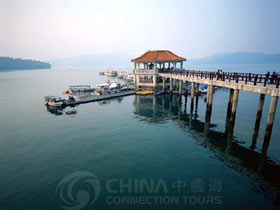Separated from Mainland China by the Taiwan Strait, Taiwan is bordered by the South China Sea in the south, the East China Sea in the north, and the Pacific Ocean on the west. Taiwan's has abundant rainfall, with goes with its tropical and subtropical climate.
Taiwan's population surpassed 22.56 million in August 2003. Kaohsiung City in the south is the most densely populated place, followed by Taipei in the north and Taichung in central Taiwan. Almost 70 percent of Taiwan's population is concentrated in metropolitan areas.
With the exception of over 433,524 indigenous peoples in 2002, Taiwan's population is composed almost entirely of Han Chinese. Early Han Chinese immigrants are of two groups: the Hakka, mostly from Guangdong Province, and the Fujianese, from China's southeastern coastal province of Fujian. These two groups comprise about 85 percent of the Han population, with the Fujianese outnumbering the Hakka by about three to one. The last group of immigrants came to Taiwan from various parts of China with ROC government in 1949. This group is generally referred to as "mainlanders," and accounts for less than 15 percent of the Han population.
Both the culture and lifestyles of Taiwan's indigenous peoples have continued to change as the descendants of Taiwan's earliest inhabitants adjust to rapid modernization. Young people are leaving traditional occupations, such as farming, hunting, and fishing for jobs in the cities. Indigenous languages are still spoken in Taiwan, but the number of native speakers is dwindling rapidly, with younger generations usually not as fluent in their own ancestral tongue as they are in Mandarin or Minnanese.
Sculpting and calligraphy are part of the traditional Chinese arts. Painting is another popular form of art in Taiwan. The West began influencing Taiwan's culture in the 1950's and 60's. Western art and literature influenced the work of many Taiwanese writers and artists. Western clothing also became popular. Many ancient holidays and customs of China are still celebrated in Taiwan. Popular festivals include the Dragon Boat Festival, the Mid-Autumn Festival, and the Feast of Lanterns.
 Think of Taiwan and the first thing that will spring to mind is probably the 'Made in Taiwan labels attached to so many clothes purchased in the Western world, which will have no doubt contributed to the perception of Taiwan as some industrial landscape defined by hundreds of factories and warehouses, and precious little else to offer visitors. Taiwan might have been known as one of the 'tiger' economies of Asia, but few people, until recently at least, thought of this small island off the southeast coast of China as a potential tourist destination.
Think of Taiwan and the first thing that will spring to mind is probably the 'Made in Taiwan labels attached to so many clothes purchased in the Western world, which will have no doubt contributed to the perception of Taiwan as some industrial landscape defined by hundreds of factories and warehouses, and precious little else to offer visitors. Taiwan might have been known as one of the 'tiger' economies of Asia, but few people, until recently at least, thought of this small island off the southeast coast of China as a potential tourist destination.
The Central Region of Taiwan (Taichung, Sanyi, Changhua) display natural beauty: mountain lakes, roaring rivers and hot springs, emerald forests and craggy ravines. There are tourist centers inside the Taichung city area, like Zhongshan Park, Baojue Temple and Confucian Temple. You can select a trip for Taichung and Sun Moon Lake, Taiwan Alishan, Taroko Gorge Gateway, Nantou and Hualien Stone Sculptural Park.

